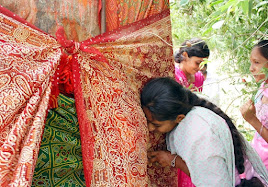Why we celebrate janmashtami?
Vrajwani Dham
Hare Krishna
Yes, that's True...
There is a village name Vrajwani located on the banks of a large desert in Rapar taluka of Kutch (Gujarat, India). Today there is a grand temple here. If you go inside the temple, you will see a completely different view from all other pilgrimage sites. Different because here you will find 140 statues of women in a circle! Outside, there is another large area in the courtyard. These 140 women are Ahirani of Kutch.
It is said that Krishna had promised his Gopi's he will visit them and give his darshan. So around 600 years ago, In Vrajwani Dham of Kutch, Krishna took avatar in the form of Dholi (the person who plays drum) and he started playing drum. The music from the drum was so magical that 140 woman that is Ahirani of that village came together and started doing Rass (form of dance). Almost 3 days continuously the dholi played the drum and the 140 Ahirani didn't stopped. Seeing this one of the youngster of that village went to meet the dholi but till that time Krishna disappeared and the women who were dancing on the beats of drum stopped.
The 140 Ahirani of that village prayed to Krishna that, "There is no fascination left in this world and requested him to take them to his abode". After saying this 140 Ahirani left their soul together and went to the abode of Krishna. There are still 140 pillars of Ahirani at the same place from where they left and there is also a pillar from where Krishna disappeared. It is said that by listening to that pillar carefully, you can still hear the sound of that drum.
Even today many people come to Vrajwani Dham and bow their heads in front of Ahirani's Palanquins.
For more such Mythological Facts Follow and Stay Tuned...
Radhe Radhe!!!
Krishna and his 16108 Wives
-
Hare Krishna Kollur Mookambika Temple is located near the holy river Sauparnika in Kollur Region of Karnataka, India . The templ...
-
Hare Krishna Daivas are worshiped in Southern Karnataka and part of Kerala . They are considered as Demigods ( Bhuta ) to whom cert...
-
Hare Krishna Bhishma Pitamah , also known as Bhishma , is a central character in the Indian epic, the Mahabharata . He was a promine...















